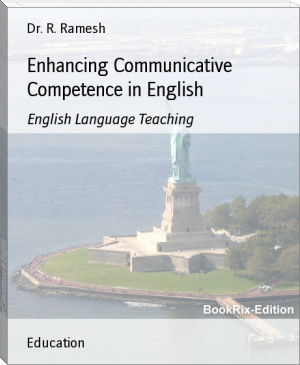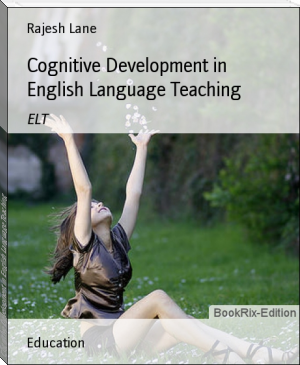Communicative Competence in English by Dr. R. Ramesh (best ereader manga TXT) 📖

- Author: Dr. R. Ramesh
Book online «Communicative Competence in English by Dr. R. Ramesh (best ereader manga TXT) 📖». Author Dr. R. Ramesh
Krashen and Terrel give little attention to theory of language. They stressed the importance of vocabulary because they believed that language is essentially lexicon, and grammar determines how this lexicon is exploited to produce messages. They viewed language as a vehicle for communicating meaning and messages. Principal tenets of Natural Approach include 1. Acquisition or learning hypothesis 2. Monitor hypothesis 3. Natural order hypothesis. 4. Input hypothesis. 5. Affective Filter hypothesis.
Krashen and Terrel list out goals of language teaching under four areas.
1. Basic personal communication skills [Oral] 2. Basic personal Communication skills [Written]
3. Academic learning skills [Oral]
4. Academic learning skills [Written]
These goals are attained through situational practice. They adopt techniques from Total Physical Response, Direct Method and Communicative Language Teaching for developing teaching and learning activities. This method helps to provide comprehensible input to minimize the learner anxiety and to maximize learner’s self confidence.
IX. Suggestopedia
Bulgarian Psychiatrist Georgi Lozanov developed this method. Suggestopedia is derived from ‘suggestology’, which is described as “a science concerned with the systematic study of the non-rational and non conscious influences that human beings are constantly responding to” (Richard and Rogers 143). Peculiarity of this method lies in its settings, in the decoration, furniture and arrangement of class room, use of music and the authoritative behavior of the teacher.
In suggestopedia, Lozanov applied ideas he has taken from Raja Yoga and Soviet Psychology. From raja yoga he has borrowed techniques for altering the state of consciousness and concentration and the use of rhythmic breathing. From soviet psychology, he has taken the notion that all students can be taught a given subject matter at the same level of skill. He promised success for both gifted and below average learners through this method.
Suggestion is the main part of suggestopedia. Lozanov claimed that his method has a ‘de suggestive-suggestive sense’. There are six principal theoretical components which help for the operation of suggestion and de suggestion. They are, Authority, Infantilization, Double planedness, Intonation, Rhythm and Concert Pseudo Passiveness.
Main objective of Suggestopedia is to gain advanced level of conversational proficiency. It helps for understanding and creative solution of problems. Its syllabus consists of thirty days course with ten units of study. Central focus of each unit is dialogue with vocabulary list and grammatical commentary. Classroom procedures include oral review session, presentation of new material and séance or concert session.
X. Communicative Language Teaching [CLT]
Communicative Language Teaching [CLT] originates from the British Language Teaching tradition of late 1960s. Before that Situational Approach represented major British Approach to teaching English as a foreign language. Noam Chomsky criticized Situational Language Teaching in his classic book Syntactic Structures (1957). He views that structural theories of language were incapable of developing creativity and uniqueness of individual sentences.
British applied linguists emphasized the functional and communicative potential of language. They want to focus on communicative proficiency in language than mere mastery of the structures. Christopher Candlin and Henry Widdowson supported this view due to the influences of British functional linguists, American socio-linguists and philosophers.
In 1971, a group of linguistic experts focussed on developing a language course on a unit credit system in which learning tasks was broken down into small units according to the learner needs. They studied the needs of European language learners and the preliminary document was prepared by a British linguist D.A.Wilkins. From their study, they proposed a functional or communicative definition for developing communicative syllabus for language teaching.
Wilkins analyzed communicative meaning which a learner needs to understand. He attempted to demonstrate the system of meaning in the communicative uses of language. He described two types of meaning as notional categories and categories of communicative functions. Notional categories involve the categories of time, sequence, quantity, location and frequency. Categories of communicative functions include requests, denials, offers, complaints, etc. He had published all these views in a book form entitled Notional Syllabuses in 1972. This book led to the development of communicative Language Teaching. Communicative Approach gained national prominence after Council of Europe had applied this to text book preparation and language teaching.
The scope of Communicative Language Teaching expanded after the mid 1970s. British and American proponents viewed it as an approach rather than a method. “It aims to make communicative competence the goal of language teaching and develop procedures for the teaching of the four language skills that acknowledge the interdependence of language and communication” (Richard and Rogers 66). William Littlewood opines that “one of the most characteristics features of communicative language teaching as that it pays systematic attention to functional as well as structural aspects of language” (Richard and Rogers 66).
Howatt identified two versions of Communicative Language Teaching. They are Strong version and. Weak version. Strong version claims that language is acquired through communication. It supports the view of ‘using English to learn it’ Weak version stressed the importance of providing opportunities to use English for communicative purposes. It entails ‘learning to use English’.
The focus of communicative and contextual factors in language use had its traces in the works of anthropologist Bronislaw Malinowski and his collegue and ligiuist John Firth. Firth focused on discourse as subject and context for analysis. He insisted that language should be studied in the broader socio-cultural context. This socio-cultural context of language use includes participants their behaviors and beliefs, the object of linguistic discussion and word choice. Del Hymes and Michael Halliday were primarily indebted to these two linguists for their contributions on Communicative Language teaching.
Communicative Language Teaching is a learner centered and experience based view of second language teaching. “It is a theory of language teaching that starts from a communicative mode of language and language use, and that seeks to translate this into a design for an instructional system, for materials for teacher and learners roles and behaviours, and for classroom activities and techniques” (Richard and Rogers 69).
Approach
Communicative approach starts from the theory of language as communication. Most important goal of language teaching is to develop ‘communicative competence’. Hymes coined this term in order to contrast a communicative view of language and Chomsky’s theory of competence (Richard and Rogers 69). Chomsky’s linguistic theory focussed on abstract abilities of the speaker which enable him to produce grammatically correct sentences. Del Hymes viewed that linguistic theory was a part of general theory which links communication and culture. “Hyme’s theory of communicative competence was a definition of what a speaker needs to know in order to be communicatively competent in a speech community” (Richard and Rogers 70).
Many theories evolved on the basis of these theories. Halliday’s functional account of language use concerned with the description of speech acts and text. Henry Widdowson focussed on communicative acts and the ability to use language for different purposes. Canale and Swain identified four dimensions of communicative competence as grammatical, socio-linguistic, discourse and strategic.
Few learning theories were evolved on the communicative dimensions of language. Basic elements of these theories are discerned from CLT practices. They are communication principle, task principle and meaningful principle. They focus on the essential conditions needed to promote second language learning than second language acquisition.
Design
Piepho identified five levels of objectives. 1. an integrative and content level (language as a means of expression) 2. a linguistic and instrumental level (language as a semiotic system and an object of learning) 3. an affective level of interpersonal relationships and conduct (language as a means of expressing values and judgments about oneself and others) 4. a level of individual learning needs (remedial learning based on error analysis) 5. a general educational level of extra-linguistic goals. (language learning within the school curriculum). (Richard and Rogers 73)
Notional syllabus (Wilkins) was one of the first syllabus models developed on the basis of communicative language teaching. It includes semantic and grammatical categories and categories of communicative functions. Council of Europe expanded Wilkins’s Notional Syllabus to suit the objective of foreign language courses for European adults. This include
1. Situation in which learners need to use a foreign language.
2. Topics they need to talk about.
3. Notions made use in communication
4. Vocabulary and grammar needed. British applied linguists criticized Wilkins’s Notional model because it specified on product rather than process.
Communicative Language Teaching has unlimited range of exercises and activities. Littlewood observes two major type of activity in CLT. They are functional communication and social interaction activities. In communicative Language Teaching, learners have to act the role of negotiator between self and learning process. They have a preconception of what teaching and learning should be like. Teachers have different roles like facilitator of communication, organizer of resources, guide, researcher, need analyst and group process manager.
Communicative Language Teaching uses a variety of instructional materials for language teaching. These instructional materials are divided into three types. They are Text-based materials, Task-based materials and Realia.
Communicative Language Teaching is considered as an approach than a method. Teachers who prefer humanistic approach to language teaching adopted this method easily. It has got widespread approval and assumed higher position among other British language teaching circle.
Advantages of communicative Language Teaching
Communicative Language Teaching aimed at application theoretical perspectives in communicative competence as the pivot of language teaching. It acknowledges the interdependence of language and communication. Chief goal of Communicative Language Teaching is to enable students to communicate in the target language. It treats communication as a process. Unlike other methods, it gives undue importance to the knowledge of forms of language. Here a teacher has to assume variety of roles like facilitator, planner, organizer, adviser, monitor of student’s performance and communicator.
In Communicative Language Teaching, each and every activity is done with a communicative intent. Here the learner is exposed to target language through different communicative activities such as games, role play, problem solving, discussion etc. Here the learners have the freedom to select suitable language items. Communicative activities in CLT have some special features like information gap, choice and feedback facilities for the active participation and communication. Here the communication activities involved are purposeful and the speakers can evaluate themselves based upon the information they receive from the listener. Immediate feed back promotes effective communication. Activities practiced through small groups provide maximum time for each learner.
Most of the methods discussed here aimed at developing communication skill of the learners. All these methods are devised to practice inside the class room. Almost all the methods assign different roles for teachers and learners. Some methods avoid the use of mother tongue in the classroom (Direct method) but some methods like Grammar-Translation methods and Community Language Learning encourage its usage. Accuracy in grammar and structures of language are the main goals of Direct method and Grammar-Translation method but CLT, Natural Approach and Community Language Learning neglect this aspect and encourage communication in the target language. Classroom procedures are limited and teacher has to follow the predetermined steps in Audio-lingual Method, Suggestopedia and Total Physical Response. Teachers can enjoy unlimited freedom in Communicative Language Teaching and Community Language Learning.
Merits of Communicative Language Teaching over other methods are the following.
1. Meaning is paramount than structure and form.
2. Enhancement of learner’s personal experience encourages classroom learning.
3. It links classroom language learning with language activities of outside the class room.
4. It makes use of both functional activities and social interaction activities.
5. Formal properties of language are practiced along with its usage and language forms are introduced with context.
6. Learners are encouraged to find out forms and structures of language for themselves.
7. Attaining communicative competence is the desired goal of CLT.
8. Judicious use of native language is accepted.
9. A
 The desire to acquire knowledge about the surrounding world and human society is quite natural and understandable for a person. Life is so developed that an uneducated person will never occupy a high position in any field. Humanity in its mass, and each person individually, develops objectively, regardless of certain life circumstances and obstacles, but with different intensity. The speed of development depends on the quality of training.
The desire to acquire knowledge about the surrounding world and human society is quite natural and understandable for a person. Life is so developed that an uneducated person will never occupy a high position in any field. Humanity in its mass, and each person individually, develops objectively, regardless of certain life circumstances and obstacles, but with different intensity. The speed of development depends on the quality of training.




Comments (0)